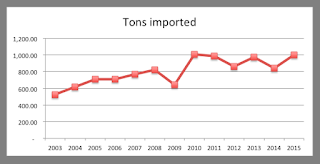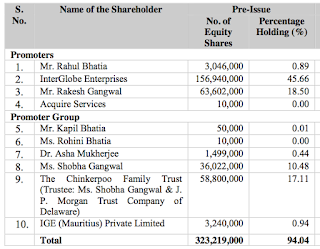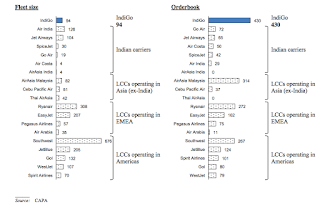Can someone run a business and become a billionaire
snubbing investors? May be the title of the article is incongruous, or may be there is a real snub out there what with 5.80% return on equity.
Whatever that is, Mr. Kazuo Inamori must be a great guy with motives towards welfare of his employees. As per the story in the article, he was able to amass huge wealth focusing on making staff happy, let's call it creating employee value. He must have also created shareholder value in the process; he let Japan Airlines come out of bankruptcy. His lines:
If you want eggs, take care of the hen; At times company management has to say no to shareholders' selfish requests. And the response from the shareholders was,
we are shareholders and not selfish shareholders. Mr. Inamori apparently acknowledges that the companies do belong to the shareholders, however, he is quick to extend that
hundreds or thousands of employees are also involved, and then he says, the hen has to be healthy.
What I am not clear though is, who is the hen here. I would like to argue that if Mr. Inamori's businesses are any successful in increasing their long term returns, the hen would be shareholders, not employees. Mr. Inamori must have focused on creating shareholder value through the means of making his employees happy. Never mind if there has been some mix-up over who the hen is.
This brings us to think about the purpose of a firm. Although arguments on this topic are unresolved, the favorite choices remain: shareholder value, customer value and society value creation.
Here's my take. Any business, small or big, private or public, listed or unlisted, national or multinational, is started by the owners, with a combination of their own and borrowed capital, in order that they make money out of it. If this was not true, they would not be spending their time, resources and efforts. In an owner-managed business, the owner would both supply capital and operate the business. In a professionally managed business, the owners employ outside managers to operate the business as per their mandate; the managers would get paid for the services and final profits would accrue to the owners. The owners' goal here is not to make anybody but themselves happy, and happy they would be, if only they make money; otherwise they would do something else, not start a business. Of course, they would have to operate their business within legal boundaries set by the regulation and moral boundaries set by the society. If making money for themselves requires anything to be done, they would willingly do it. For instance, if happy employees would make more money for the firm, the owners would like to take good care of their employees; if it requires making customers happy, so be it.
What is important is to know the final objective of a business. The end is to generate cash flows, more the better, and there could be several means - making employees, customers and society happy. Therefore, creating long term value for shareholders is the only objective of a business.
A business operates as a going concern, usually until perpetuity. It is clear therefore that the shareholders would look for long term profits and value creation rather than short term. It is true for a private business and also for a publicly listed business. For a listed firm, there are many distractions, the biggest one is the capital market. The market would like to grade the firm on a moment to moment basis, and at each quarter it is open to a harsh scrutiny. If managers and shareholders consider this as troublesome, they are not aligned with their thoughts. It really does not matter what happens in the short term, because there are always inefficiencies in that flawed process. What matters is the long term performance of the business. In the final analysis, stock prices follow earnings and cash flows. It is better for the business, managers and shareholders to focus on the long term than think about what would happen in the short term.
In this respect, there is no need to
reinvent the purpose of the firm as this report calls for. The article calls it the age of customer capitalism, as opposed to shareholder capitalism, and supplies a series of confused arguments. It gives example of four firms, Coca-Cola and GE as proponents of shareholder value, and Johnson & Johnson and Procter & Gamble as proponents of customer value. It argues that there is no sign that shareholders benefited more when their interests were put first and foremost.
My intention is not to disagree with the author personally, rather with everyone, who is from that school of thought. The article then goes on to say that to create shareholder value, you should instead aim to maximize customer satisfaction. Our response to that muddling is, who said no? Note that it starts the sentence with
to create shareholder value, which means it implicitly accepts that the end is the creation of shareholder value, but fails to put it explicitly.
A CEO should do whatever it takes to ensure enhanced returns for the shareholders. If that takes making customers happy, the CEO should take it as a task.
Consider this: If happy customers do not translate into high return on the invested capital, why would shareholders continue to invest? It is called throwing good money after bad. Capital is not available free of cost. Let's take an example. Imagine that there is a business, which either due to being a monopoly or some other uniqueness has immense pricing power. Let's assume that because of this power, it is able to charge more than what its customers feel fair, and consequently it makes customers somewhat unhappy, and yet is able to make money. Would managers and shareholders think in these lines -
this business is too good, makes a lot of money for us, but our customers are unhappy, we cannot see it, let's close the business or charge them less and earn less for ourselves - would they?
The article throws yet another argument: that the only sure way to increase shareholder value is to raise expectations about the future performance of the company. While it acknowledges that there is a behavioral aspect to this in the markets, it fails to bring forth the economic reasoning behind allocation of capital. The manager's role is to ensure that capital supplied by shareholders is suitably allocated to projects that earn more than their cost of capital. This is not an overnight's journey, but a long one. Those who are not tuned to this thinking, whether managers or shareholders, should rather stay away, and look somewhere else.
I find the article's most flawed argument: Executives come to understand that shareholder value creation and destruction are cyclical, and more important, not under their control. How can we respond to this? If shareholder value creation is not in their hands, in whose hands are they? Why have shareholders picked these managers for? A CEO's job is to maximize the value of the firm, which requires obtaining a right mix of capital, allocating capital in the right projects, and paying out excess cash generated back to shareholders. These decisions are to be taken considering long term economic impact on the business and its value, not based on the dancing notes of speculators and traders. Short term gyrations are best to be ignored; when such alignment exists between executives and shareholders, shareholder value creation is warranted.
Value of a firm is the present value of its future cash flows. Managers can destroy value in several ways with short term tactics, which they often do - take projects that do not earn their cost of capital, pay too much for growth, take on excessive leverage - to manage quarterly earnings and increase immediate stock prices. This does not, however, change the objective of the business.
Stock-based compensation is another aspect that is misunderstood. Stock options are given basically to align the thoughts of managers with that of shareholders. If managers are shareholder oriented and believe in long term economics of the business, they can buy stocks from open market themselves with their own cash. They need not rely on stock options for that. When we find top managers, who do not keep their stocks for long, it is safe to conclude that they are not shareholder oriented.
The article says that companies should seek to maximize customer satisfaction while ensuring that shareholders earn an acceptable risk-adjusted return on their equity. I would like to ask, what if companies are able to give an acceptable return on equity to shareholders despite making their customers slightly unhappy?
The article then promptly highlights Johnson & Johnson's credo, which according to it, gives shareholders last priority compared to the doctors, nurses, patients, customers, employees and communities. As I read the last sentence of the credo which states that when we operate according to these principles, the stockholders should realize a fair return, I find that again the primary goal appears to be shareholder value, if it was not, J&J would price its products at cost or below so that customers and society were happy. Whether CEO James Burke's recall of every Tylenol capsules across America, or more recent recall of Volkswagen vehicles across the world or recall of Maggi noodles across India, yes, it is about doing the right thing, but not for customers, it is for shareholders. If not, the long term brand image would be hit severely impacting long term profits; in such situations, it is better to take lower profits or even losses in the short term. This is again a shareholder oriented policy, not customer oriented.
The article mistakenly thinks that companies such as J&J and P&G are customer focused rather than shareholder focused, and therefore they are able to deliver impressive returns to shareholders. It is a flawed thinking. At the cost of repetition, I note that if maximizing shareholder returns requires customer satisfaction, the CEO should work towards it. However, it is a mistake to assume that customer satisfaction is the primary focus and shareholder profits are incidental.
A good CEO is one who understands shareholder value well enough, and runs the business accordingly. This involves taking investing, financing and dividend decisions in the best interests of shareholders. It is not about increasing stock prices in the short term, thus making way for managers and traders. It is about increasing long term economic value of the firm, which when done increases the stock price eventually. Investing in stocks, as opposed to playing in the derivatives, is not a zero-sum game. Here, the stockholders are rewarded for supplying capital to a well run business. This business, operating under free market environment, will be doomed in the long run if it continues with the policy of ill treating employees or charging excessively to its customers. The competition will ensure destruction of its image, business and eventually, value. The decisions taken here are business decisions which are shareholder oriented.
In conclusion, while creating shareholder value is the single objective of a business, creating employee, customer and society satisfaction is only a means to that end. If the primary goal is creating value to customers and society, the capital providers should look towards charity, not business profits. They are noble thoughts, but not ethos of business.

































